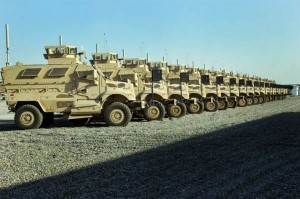
The heavy vehicles that protect soldiers from improvised explosive devices, only get about three miles per gallon, a major problem.
President Barack Obama’s energy czar, Carol Browner, made a quick visit to Detroit this week to discuss research and development in the auto industry. One thing that became apparent during her short stay in the Motor City, the U.S. Department of Defense is eager to use all-electric vehicles in the future.
Concern over whether electric Vehicles can actually satisfy consumers has hung over the development of electric vehicles for decades. However, one influential consumer, the U.S. Army, has seen enough and heard enough to emerge as a huge EV fan.
It’s seems even the DOD is eager to dump its Hummer franchise.
Grace Bochenek, director of the U.S. Army Tank Automotive Research, Development and Engineering, center told Browner the goal right now is to move to use nothing but electric vehicles for ground operations in the future. “We hope to be driving all-electric vehicles by 2025,” she said. Driving the move to electric vehicles is cost, she said.
The DOD pays an enormous bill for petroleum every year and its continues to increase as the Humvees (High-Mobility Multipurpose Wheeled Vehicles) and MRAPS (Mine Resistant Ambush Protected), the heavy duty patrol vehicles that protect soldiers from improvised explosive devices, only get about three miles per gallon, she said. With such poor range, the cost and protection of fuel supplies is a major issue for combat forces.
The Army needs to do better, she said.
Dependence on foreign oil to move the U.S. Army vehicles is also a national security issue that needs to be addressed. It is of course a national security issue of the entire country.
Bochenek also said the Army wants to work closely with the auto industry on the development of electric vehicles, high-tech batteries and materials that could both protect soldiers and also cut the weight of vehicles, driving improvements in fuel economy.
The DOD’s interest in electric vehicles and hybrids isn’t anything new. For a decade or longer the DOD’s interest in the technology has been a force pushing research on the technology
The DOD’s commitment to hybrid and electric vehicles in fact has become one of the driving forces in the development of the technology. The Q-Drive from Quantum Technologies being deployed in the Fisker plug-in electric sports car was engineered under contracts with the DOD.
Beth Lowery, General Motors vice president of energy and environment, said the U.S. also needs to focus research on battery technology in the short-term but also on longer-term projects such as fuel cells.
For her part, Browner, whose official title is Presidential Assistant for Energy and Climate Change, said the administration was committed to developing a comprehensive automotive policy that took into issues such as national security and long-range research and development. The policy also should be “technology neutral,” she said. “I’d rather see a lot of competing technologies,” she said, including diesel.
“Frankly I’m surprised there hasn’t been more clean diesel technology,” said Browner, who approved the clean diesel regulation nine years ago when she was director of the Environmental Protection Agency under Bill Clinton.
Ultimately, she said one of the administration’s principal goals is to “start down the path of breaking our dependence on foreign oil,” she said.

If the US military converts to electric tanks, will the enemy convert to water pistols?
Funny thing, Dan, is that the military actually does like the idea of going to alternative power, if possible, though pure electric is probably low on their list.
A few years ago, the tank command center showed off fuel cell-powered vehicles that had the advantage of a virtually invisible infrared signature — since no significant heat from the exhaust. That, they said, would make it more difficult for an enemy to spot the vehicle and, I would assume, also would make it harder for a heat-seeking missile to lock onto.
Paul A. Eisenstein
Bureau Chief, TheDetroitBureau.com